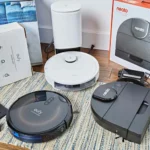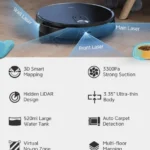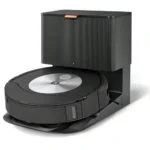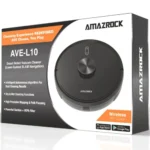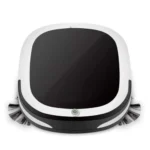Have you ever wondered how your smart vacuum cleaner knows where to go and how to navigate your home seamlessly while picking up dust and debris? The navigation system of a smart vacuum cleaner is a technological marvel that relies on sensors, mapping, and algorithms to optimize cleaning performance. In this article, we will dive deep into the basics and advanced technologies used in smart vacuum cleaner navigation systems. We will also explore the various navigation modes and considerations when choosing the best smart vacuum cleaner for your home. By the end of this article, you will have a better understanding of the magical ways that your smart vacuum cleaner navigates your home.
Section 1: Basic Navigation Technology
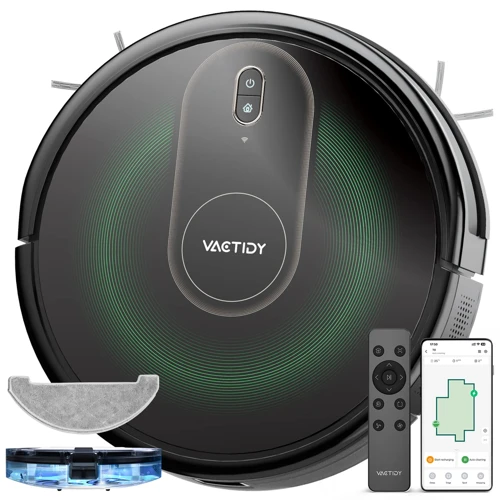
As we venture into the world of smart vacuum cleaners, understanding the technology behind their navigation system is vital. A smart vacuum cleaner’s ability to navigate around a room with precision and efficiency is what sets them apart from their conventional counterparts. In this section, we will explore the basic navigation technology that smart vacuum cleaners use to move around the room, including cliff sensors, bump sensors, and optical sensors. To learn more about the role of sensors in smart vacuums, check out our article on sensors in vacuum cleaners.
1.1 Cliff Sensors
Cliff sensors are one of the basic navigation technologies used in smart vacuum cleaners. The purpose of cliff sensors is to prevent the vacuum cleaner from falling off edges such as stairs or ledges. These sensors detect sudden drops in elevation in the path of the vacuum cleaner, allowing it to change its direction or stop right before it falls off the edge.
Cliff sensors are equipped with an infrared sensor system that sends out a beam of light to detect the distance between the vacuum and the floor. When the sensor detects a drop in the distance, it signals the vacuum to stop or change its direction to avoid falling off.
Having cliff sensors installed is essential for the safety of the vacuum cleaner, especially if you have stairs or other elevated areas in your home. Smart vacuum cleaners with this technology are able to navigate around the house without the risk of falling, giving you peace of mind while it does its job.
If you are interested in learning more about the various technologies used in smart vacuum cleaners, read our article on the role of AI in smart vacuum cleaners. Additionally, if you want to know more about how smart vacuum cleaners detect obstacles, check out our article on smart vacuum obstacle detection.
1.2 Bump Sensors
Bump sensors are another type of navigation technology used in smart vacuum cleaners. These sensors are located on the vacuum’s body and work by detecting obstacles through gentle collisions. When the vacuum comes in contact with an object, the sensor sends a signal to the control panel to stop and move the vacuum in a different direction. The bumper sensor can be either mechanical or electrical in nature.
Mechanical bump sensors use a physical switch that is triggered when the vacuum hits something. On the other hand, electric sensors use a micro-switch that sends an electrical signal to the control panel.
One of the benefits of using bump sensors is that they are cost-effective, which makes them a popular option for lower-priced models of smart vacuums. The vacuum using the bump sensor technology move around the room systematically, bouncing off walls and furniture to create an area map. Once the map is created, it uses this information to navigate around the room more efficiently.
However, there are certain limitations to using bump sensors. Since these sensors are not accurate, they can accidentally push objects out of the way or can miss surfaces that are not directly up against the body of the vacuum. Additionally, the bump sensor is not useful when navigating around unstable objects, as a gentle bump would be enough to knock the object over.
Bump sensors are an effective and affordable navigation technology used in smart vacuum cleaners. They allow the vacuum to avoid obstacles by gently pushing objects out of the way. However, the accuracy of the sensor can be a limiting factor and can lead to missing surfaces or pushing objects over. Nevertheless, by combining bump sensors with other navigation technologies, such as laser mapping or SLAM, smart vacuums can provide more accurate and efficient cleaning results. For more information regarding navigation modes, check out our article on smart vacuum cleaning modes.
1.3 Optical Sensors
Optical Sensors are one of the essential components used in modern smart vacuum cleaners to improve their navigation systems. These sensors project light beams onto the floor and use their reflections to map out the environment around them.
One significant benefit of Optical Sensors is that they provide a high level of accuracy when identifying objects, even small ones. Optical Sensors also work well in various lighting conditions, making them versatile enough to use in any room.
The table below highlights the advantages and disadvantages of Optical Sensors:
| Advantages | Disadvantages |
|---|---|
| Very accurate in detecting obstacles. | May have difficulty detecting some types of transparent or reflective surfaces. |
| Effective in various lighting conditions. | Can struggle to work in areas with low lighting. |
| Can map out and remember the floor-plan of a room very well. | Hardware may add extra expenses for the customer. |
Another advantage of Optical Sensors is that they are less invasive than other sensors. They do not require physical contact with objects to detect their presence, as bump sensors do, making them less likely to damage furniture or other fragile objects.
However, Optical Sensors do have some shortcomings. They may have difficulty detecting some types of transparent or reflective surfaces. Additionally, they may struggle to work in areas with low lighting.
Optical Sensors are an important component in the Navigation System of Smart Vacuum Cleaners. They are reliable, accurate, and effective in mapping the floor-plan of a room. They improve the performance of smart vacuums and enhance the cleaning experience for customers.
Section 2: Advanced Navigation Technology
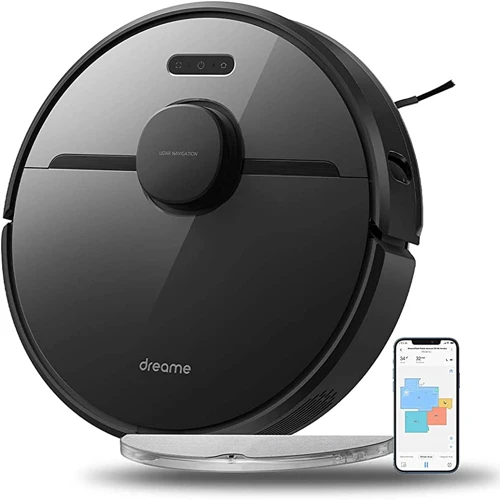
Smart vacuum cleaners have become an essential household item in recent years, and manufacturers have been continuously improving the features and functionality of these modern cleaning devices. In this section, we will explore the advanced navigation technology used in smart vacuums, which goes beyond the basic bump and cliff sensors. These cutting-edge technologies include laser mapping, SLAM technology, and camera-based navigation. We will also discuss the benefits of these features and explore how they can enhance cleaning efficiency and effectiveness. For those interested in the significance of Wi-Fi connectivity in smart vacuums, check out our article on the significance of Wi-Fi in smart vacuums. Additionally, for information on how a smart vacuum cleaner maps out a room, see our article on smart vacuum cleaners’ room mapping.
2.1 Laser Mapping
Laser mapping is a revolutionary technology that drastically improves the navigation system of smart vacuum cleaners. Instead of relying on sensors and cameras to navigate, laser mapping creates precise and accurate 3D maps of the home, allowing the vacuum cleaner to move around with ease.
How does laser mapping work?
- The vacuum cleaner emits a laser beam that scans the entire room.
- The laser reflects off surfaces in the room and returns to the vacuum cleaner, creating a map of the room’s layout.
- The vacuum cleaner uses this map to navigate around furniture and obstacles.
Benefits of laser mapping
- More efficient cleaning: With a map of the room, the vacuum cleaner can clean in straight lines instead of randomly moving around.
- Greater precision: Laser mapping allows the vacuum cleaner to be more precise in its movements, avoiding collisions and getting into tight spaces.
- Improved battery life: Since the vacuum cleaner doesn’t have to waste time moving in random directions, it can clean more efficiently and use less power.
- Easy maintenance: Some laser mapping systems come with a maintenance schedule that tells you when to clean and replace parts.
Examples of vacuum cleaners that use laser mapping
- Roborock S6: This vacuum cleaner uses laser mapping to create 3D maps of your home and navigate precisely.
- Neato Botvac D7: With laser mapping and SLAM technology, the Neato Botvac D7 creates a map of your home and cleans in straight lines.
- Xiaomi Mi Robot Vacuum-Mop Pro: This vacuum cleaner uses laser mapping to scan and map the entire room, then uses AI to choose the most efficient cleaning route.
Conclusion
Laser mapping is a powerful technology that greatly improves the navigation system of smart vacuum cleaners. With its advanced mapping capabilities, laser mapping allows for more efficient cleaning, greater precision, improved battery life, and easy maintenance. As the technology becomes more widely adopted, we can expect to see even more advanced smart vacuum cleaners that utilize laser mapping to clean our homes.
2.2 SLAM Technology
SLAM (Simultaneous Localization and Mapping) technology is a cutting-edge navigation technology used in smart vacuum cleaners to create a precise and accurate map of the cleaning environment. This technology relies on a combination of sensors, software algorithms, and advanced processing capabilities to identify and map out the cleaning environment.
SLAM Technology Components
The key components of the SLAM technology used in smart vacuums are:
| Component | Description |
|---|---|
| LIDAR Sensor | A laser-based sensor that scans the surrounding area and creates a detailed map of the environment. |
| Visual Odometry | Uses the input from the LIDAR sensor and the robot’s camera to track its movement relative to the environment. |
| SLAM Algorithm | A software algorithm that uses the input from the LIDAR and visual odometry to build a detailed, accurate map of the environment as the robot navigates around. |
How SLAM Technology Works
When a smart vacuum cleaner equipped with SLAM technology starts cleaning, its LIDAR sensor scans the surrounding area and creates a detailed map of the environment. The robot then uses visual odometry to track its movement relative to the environment, allowing it to determine its current location on the map.
As the robot moves around, the SLAM algorithm uses the data from the LIDAR sensor and visual odometry to update the map in real-time, creating a highly accurate and detailed map of the environment. This allows the robot to make more precise and efficient cleaning paths, avoiding obstacles and detecting areas that have already been cleaned.
Benefits of SLAM Technology
SLAM technology offers several benefits over other navigation technologies, such as bump or optical sensors. The key benefits of SLAM technology include:
– More precise and accurate mapping of the environment, allowing for more efficient and effective cleaning.
– Better obstacle detection and avoidance capabilities, resulting in fewer collisions and less damage to furniture and walls.
– Ability to adapt to changes in the environment, such as the movement of furniture or the addition of new obstacles.
SLAM technology represents a significant advancement in the navigation capabilities of smart vacuum cleaners, allowing for more effective and efficient cleaning of homes and offices.
2.3 Camera-Based Navigation
Camera-based navigation is a highly advanced technology that uses a camera or multiple cameras to navigate around a home. Instead of using sensors or lasers, the cameras capture and interpret images to determine the location, orientation, and distance of objects in the room. This allows the robot vacuum cleaner to navigate intelligently, avoiding obstacles and cleaning thoroughly.
Pros and Cons of Camera-Based Navigation
| Pros | Cons |
|---|---|
| Highly accurate navigation | May struggle in low-lit areas |
| Efficient cleaning due to accurate mapping | More expensive than basic navigation systems |
| Adapts to changing environments | May have difficulty recognizing black or reflective surfaces |
One of the biggest advantages of camera-based navigation is its high level of accuracy. The use of real-time images allows for the robots to navigate not only floors but also walls and ceilings. This means that they can navigate better in accurately mapping room layouts and be precise in detecting obstacles as well.
Additionally, the advanced mapping that comes with camera-based navigation can optimize cleaning routes, reducing the overall cleaning time and ensuring comprehensive cleaning results. This feature is invaluable in larger homes that require more thorough cleaning.
However, one potential downside of camera-based navigation is that it may struggle in low-lit areas, which can impact its ability to recognize its surroundings. It may also have difficulty detecting black or reflective surfaces, which can impact its ability to navigate properly.
In general, camera-based navigation is a highly advanced and sophisticated system that offers a more efficient and thorough cleaning experience for the user. While it may be more expensive than basic navigation technologies, its benefits are well worth the investment. More importantly, it offers a high level of accuracy and helps ensure comprehensive cleaning results, making it an ideal choice for those who want the best experience from their smart vacuum cleaners.
Section 3: Understanding Navigation Modes
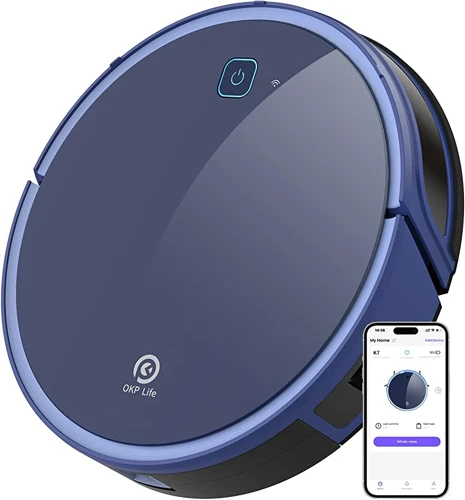
As smart vacuum cleaners become increasingly popular, it’s important to understand the different navigation modes that they use. By using different technologies and algorithms, these devices can navigate a room and clean effectively. In this section, we’ll explore the various modes of navigation that smart vacuum cleaners use and how they work. From randomly moving about a room to cleaning specific zones, we’ll dive into the intricate details of these modes to help you understand how these devices navigate your floors.
3.1 Random Navigation
Random Navigation is a common mode of operation for many smart vacuum cleaners. As the name implies, the robot moves randomly around the space without any specific plan or route. It’s a simple and straightforward method, but it can lead to some inefficiencies and missed spots.
Advantages
- Requires no prior knowledge of the floor plan or layout.
- Works well in small spaces or cluttered rooms with many obstacles.
Disadvantages
- Less efficient than other navigation modes such as pattern navigation or room-to-room navigation.
- May miss spots or leave areas uncleaned due to the random movement pattern.
- Tends to take longer to clean the same area compared to other navigation modes.
Random Navigation is best suited for smaller homes or apartments where efficiency is not a major concern. It can also be useful for cleaning cluttered rooms with many obstacles where a more systematic approach would be difficult. However, for larger homes or spaces with more open floor plans, Random Navigation may not be the best choice as it can lead to significant battery drain and missed spots.
Random Navigation can be a useful mode for some cleaning situations, but it’s important to consider the limitations and alternatives available.
3.2 Pattern Navigation
Pattern navigation is a more efficient way for smart vacuum cleaners to go about their cleaning tasks. Instead of randomly moving around the room, pattern navigation uses a specific set of motions to ensure that the entire room is cleaned without any missed spots. This method of navigation is also sometimes referred to as “grid cleaning” because the vacuum moves in a grid-like pattern across the floor.
One of the key benefits of pattern navigation is that it ensures complete coverage of the entire room. The vacuum cleaner will move in straight lines, covering each row from end to end before moving on to the next. This methodical approach is much more efficient than random navigation, which can often result in missed spots or areas that are cleaned multiple times.
Another benefit of pattern navigation is that it helps to conserve battery life. By following a set path, the vacuum can clean the room more quickly and accurately, meaning that it doesn’t need to run for as long. This can be especially important for larger rooms, where random navigation may result in the vacuum running for a longer period of time.
Pattern navigation also allows for more customization and control over the cleaning process. Many smart vacuum cleaners come with a companion app that allows you to set cleaning schedules and choose different cleaning modes. With pattern navigation, you can also specify exactly where you want the vacuum to clean, setting up virtual boundaries or “no-go zones” to keep it out of certain areas.
Pattern navigation is a highly effective way for smart vacuum cleaners to clean your floors. By following a specific grid-like pattern, these devices can ensure complete coverage of the entire room while also conserving battery life and allowing for greater control and customization. If you’re in the market for a smart vacuum cleaner, consider looking for one that uses pattern navigation for the best possible cleaning results.
3.3 Room-to-Room Navigation
One of the most convenient navigation modes of smart vacuums is Room-to-Room Navigation. As the name suggests, this mode enables the vacuum to clean a single room before moving on to the next. This mode is ideal for users who want their vacuum to give each room the same amount of attention.
Room-to-Room Navigation technology allows the robot vacuum to move from one designated area to another without needing to be carried or redirected by the user. Here is an html table that outlines the pros and cons of this navigation mode:
| Pros | Cons |
|---|---|
| – Provides even cleaning of each room | – Requires mapping of the home to be programmed into the vacuum |
| – Allows users to control which rooms get cleaned first | – Can be time-consuming to map the home in the beginning |
| – Ideal for multi-story homes with multiple rooms | – May not accommodate large open spaces or irregular-shaped areas |
Overall, Room-to-Room Navigation is perfect for those who prefer order and want a cleaning device that can follow their command. It can also be advantageous for users with multi-story homes with multiple rooms. However, it is essential to keep in mind that adequate mapping is required before using this mode.
3.4 Zone Cleaning
One of the most convenient navigation modes offered on smart vacuum cleaners is zone cleaning. This mode allows users to target specific areas in their home for a deeper clean, rather than having the vacuum roam aimlessly.
Here’s how it works:
- The user activates the zone cleaning mode on their smart vacuum cleaner. This may be done through a mobile app or directly on the vacuum itself.
- The user selects the zone(s) they want cleaned. This may be done by drawing on a map of their home via the mobile app, or by physically setting up barriers or “no-go” zones with magnetic strips.
- Once the zone(s) have been selected, the vacuum will navigate to each area and thoroughly clean it before moving on to the next one.
- After all selected zones have been cleaned, the vacuum will return to its charging dock.
Why is zone cleaning beneficial?
Zone cleaning allows users to focus on specific areas of their home that may require extra attention, such as high-traffic areas or rooms often occupied by pets. This mode also saves time and energy as the vacuum does not waste its battery power cleaning areas that do not require attention.
Zone cleaning can be especially helpful for those who suffer from allergies as it allows them to target areas where allergens are most likely to be found.
While not all smart vacuum cleaners offer zone cleaning as a mode, it is a feature worth considering for those who want greater control over their cleaning routine.
Section 4: Navigation System Considerations
As we continue exploring the navigation system of smart vacuum cleaners, it’s crucial to delve into the various considerations that should influence your purchasing decision. The efficiency of a smart vacuum cleaner’s navigation system is primarily determined by the technology in use, but there are additional factors to bear in mind. In this section, we’ll be discussing the essential navigation system considerations that you need to keep in mind before making a purchase. From floor plan mapping to obstacle detection, battery life, and maintenance, we’ve got you covered. Let’s dive in and get started with the nitty-gritty.
4.1 Floor Plan Mapping
One of the most important considerations when it comes to the navigation system of smart vacuum cleaners is floor plan mapping. A smart vacuum cleaner needs to know the layout of the home in order to effectively navigate and clean it.
Here are some key points to keep in mind:
- Mapping Technologies: Smart vacuum cleaners use a variety of technologies to map out the layout of a home. Some use laser mapping, while others use optical sensors and cameras. The quality and accuracy of the mapping technology used can greatly impact the vacuum cleaner’s ability to navigate effectively.
- Mapping Efficiency: The efficiency of the mapping process is also important. A smart vacuum cleaner should be able to map out the layout of a home quickly so that it can get to work cleaning without wasting time.
- Real-Time Mapping: Some smart vacuum cleaners are able to update their mapping data in real-time as they clean. This is particularly useful if there are changes to the layout of the home, such as moving furniture around or adding new objects.
- Multiple Floor Plans: If you have a multi-level home, it’s important to make sure that your smart vacuum cleaner is capable of storing and switching between multiple floor plans.
The floor plan mapping capabilities of a smart vacuum cleaner are essential to its performance. A well-mapped home will allow the vacuum cleaner to navigate efficiently and clean effectively, while a poorly-mapped home can lead to missed spots and wasted time. It’s important to choose a smart vacuum cleaner with high-quality mapping technology and efficient mapping capabilities.
4.2 Obstacle Detection and Avoidance
One of the most important considerations when it comes to the navigation system of a smart vacuum cleaner is obstacle detection and avoidance. Here are some key points to keep in mind:
- Sensors:
It goes without saying that a good obstacle detection system requires high-quality sensors. Most smart vacuums use a combination of sensors, including optical, infrared, and bump sensors, to detect objects in their path. - Mapping:
Some advanced navigation systems use laser mapping technology to create a detailed map of the cleaning area, which helps the vacuum to navigate around obstacles more effectively. - Virtual Walls:
Another way that smart vacuums can avoid obstacles is by using virtual walls. These are essentially barriers that you can set up in the app to prevent the vacuum from entering certain areas. - Height Clearance:
It’s important to consider the height of your furniture and other obstacles when choosing a smart vacuum. Some models have a low profile and can easily navigate under beds and other furniture, while others may get stuck. - Noise:
Some smart vacuums make a lot of noise when they encounter an obstacle, which can be annoying if you’re trying to relax or work from home. Look for a vacuum that has a quiet obstacle detection and avoidance system. - Reactivity:
One of the biggest challenges with obstacle detection and avoidance is ensuring that the vacuum reacts quickly enough to avoid collisions. Look for a vacuum with a fast and responsive navigation system.
By taking these factors into account, you can choose a smart vacuum cleaner with an effective obstacle detection and avoidance system that will help keep your floors clean and your furniture safe from damage.
4.3 Battery Life and Recharge Rate
When it comes to smart vacuum cleaners, one important consideration is battery life and recharge rate. Here are some factors to keep in mind:
- Battery life: The longer the battery life, the more area your smart vacuum cleaner can cover in one go. A good robot vacuum should have a battery life of at least 90 minutes, which is enough for a small to medium-sized room. Some models come with batteries that last up to 120 minutes, which is sufficient for larger homes or spaces. It’s important to check the manufacturer’s website or product manual for details on battery life.
- Recharge time: While battery life is important, the recharge time is equally so. Some smart vacuums may have a longer battery life, but also take longer to recharge. Ideally, you want a robot vacuum that can recharge quickly to minimize downtime. A good recharge time is around 2 to 3 hours.
- Battery type: Another important consideration is the battery type. Lithium-ion batteries are generally preferred for their longer lifespan and faster recharge times. Some smart vacuums may come with nickel-metal hydride (NiMH) batteries, which are less expensive but need to be charged for a longer period of time and have a shorter lifespan.
- Power consumption: Smart vacuums with powerful suction may drain the battery faster than those with lower suction power. Keep this in mind when selecting a model, as the battery life may vary depending on the cleaning mode.
When it comes to battery life and recharge rate, it’s important to weigh the pros and cons of each model carefully. Look for a vacuum that strikes a good balance between battery life, recharge time, and power consumption. This will ensure that your smart vacuum can clean efficiently without frequent interruptions for battery charging.
4.4 Maintenance Considerations
When it comes to smart vacuum cleaners, maintenance is an important consideration to keep your device running smoothly over time. Here are some factors to keep in mind to ensure proper maintenance and longevity of your smart vacuum cleaner:
- Cleaning Schedule: Regular cleaning of the dustbin, filter, and brush roll is essential for maintaining the suction power and overall performance of your smart vacuum cleaner. Follow the manufacturer’s instructions for the recommended cleaning schedule.
- Replacement Parts: Over time, parts such as the filter and brush roll may need to be replaced. Be sure to purchase replacement parts specifically designed for your model of smart vacuum cleaner.
- Power Cord: Check the power cord periodically for any damage or signs of wear and tear. If the cord is damaged, it should be replaced to avoid any safety hazards.
- Battery: The battery life of your smart vacuum cleaner is an important consideration, especially if you have a larger space to clean. If you notice any decrease in battery performance, make sure to replace the battery with a compatible one.
- Testing: Occasionally, test the device to ensure that it is working correctly. This can be done by simply turning on the vacuum cleaner and observing its behavior.
- Storage: Proper storage is important in maintaining the longevity of your smart vacuum cleaner. When not in use, store the device in a dry and cool place where it won’t be exposed to any potential hazards.
By regularly maintaining your smart vacuum cleaner, you can ensure that it continues to clean your home effectively and efficiently over time. Remember to follow the manufacturer’s instructions, purchase replacement parts as needed, and check the device periodically to ensure that it’s functioning properly.
Conclusion
In conclusion, understanding the navigation system of smart vacuum cleaners is essential to ensure optimal performance and efficiency. From basic to advanced technology, different navigation systems offer various benefits and limitations that should be considered when purchasing a smart vacuum cleaner.
Overall, the navigation system is crucial in ensuring that the vacuum cleaner cleans every inch of your house without damaging your furniture or other household items. As such, it is vital to choose a vacuum cleaner that is equipped with the necessary sensors, mapping technology, and navigation modes to meet your cleaning needs.
Basic navigation technology, such as cliff sensors, bump sensors, and optical sensors, come in handy for simple floor cleaning chores. However, advanced navigation technology, such as laser mapping, SLAM technology, and camera-based navigation, provides more efficient and detailed cleaning results.
The different navigation modes, including random navigation, pattern navigation, room-to-room navigation, and zone cleaning, offer diverse cleaning solutions that cover various types of surfaces and cleaning needs.
When considering a smart vacuum cleaner, floor plan mapping, obstacle detection and avoidance, battery life and recharge rate, and maintenance considerations are essential factors that should not be ignored.
Ultimately, investing in an efficient and capable smart vacuum cleaner can save you time and effort while ensuring a clean and more comfortable home. With the rapid advancements in smart technology, it is proper to say that the navigation system of smart vacuum cleaners will continue to improve, offering even more efficient and effective cleaning solutions that will make cleaning a breeze.
Frequently Asked Questions
1. How does a smart vacuum cleaner navigate a room?
A smart vacuum cleaner navigates a room using sensors, cameras, and mapping technology. It uses these sensors to detect obstacles, edges, and other features, creating a map of the room as it goes. The vacuum can then use this map to plan an efficient cleaning path.
2. What are cliff sensors?
Cliff sensors are a type of sensor that detects changes in height, such as stairs or ledges. These sensors help the vacuum cleaner avoid falling off cliffs or ledges and damaging itself.
3. What are bump sensors?
Bump sensors are a type of sensor that detects when the vacuum cleaner makes contact with an object. They help the vacuum avoid collisions and navigate around obstacles.
4. What is SLAM technology?
Simultaneous Localization and Mapping (SLAM) technology uses sensors and algorithms to create a map of a room and navigate through it. This technology allows the vacuum to locate itself within the map and plan an efficient cleaning path.
5. What is random navigation mode?
Random navigation mode is a cleaning pattern where the vacuum moves in a random pattern until it has covered the entire room. This mode is less efficient and may require multiple passes to clean the room completely.
6. What is zone cleaning?
Zone cleaning is a feature of some smart vacuum cleaners that allows users to create virtual boundaries or zones within a room. The vacuum will then clean each zone separately, allowing for more targeted cleaning.
7. Can smart vacuum cleaners clean multiple rooms?
Yes, some smart vacuum cleaners have room-to-room navigation mode, which allows them to navigate between multiple rooms and clean each one before moving on to the next.
8. What are maintenance considerations for a smart vacuum cleaner?
Maintenance considerations for a smart vacuum cleaner include emptying the dustbin regularly, cleaning the filters, and checking for any damage to the sensors or brushes. It is also important to follow the manufacturer’s instructions for maintenance and cleaning.
9. How long do smart vacuum cleaners typically run before needing a recharge?
The run time of a smart vacuum cleaner varies depending on the model and battery capacity. However, most smart vacuum cleaners can run for up to 90 minutes before needing a recharge.
10. Can smart vacuum cleaners be controlled via a smartphone app?
Yes, many smart vacuum cleaners can be controlled via a smartphone app. This allows users to start and stop cleaning sessions, schedule cleanings, and adjust settings from anywhere with an internet connection.

